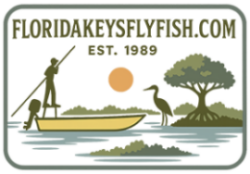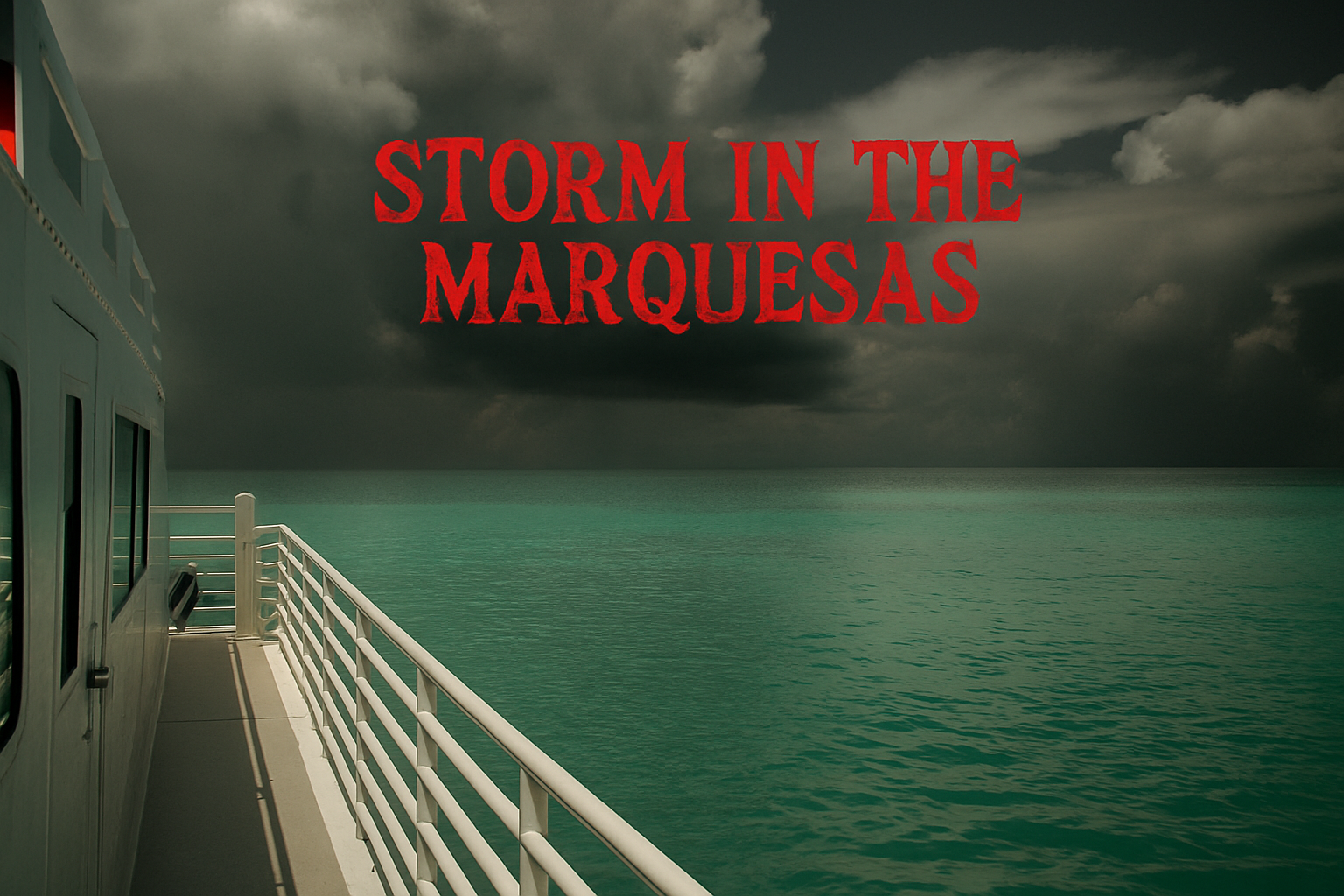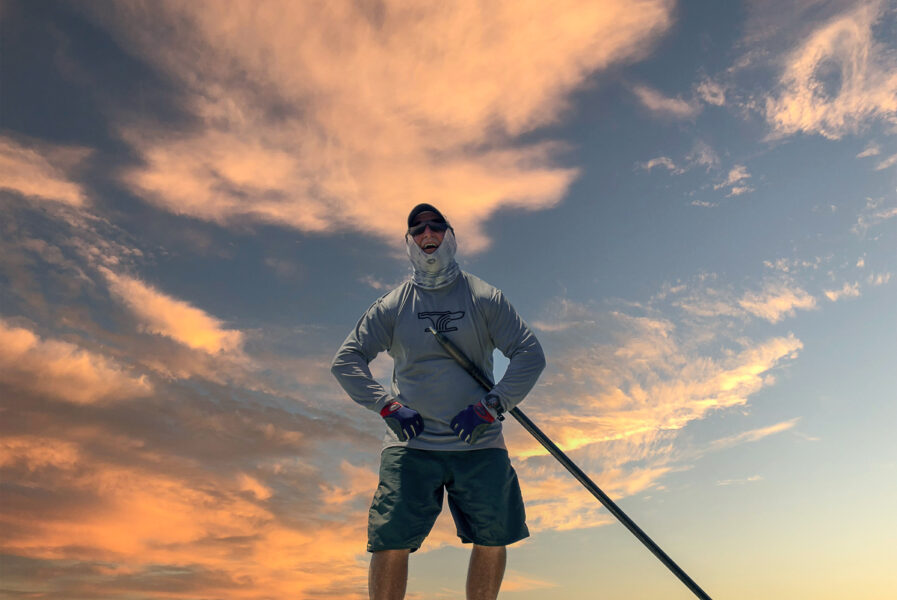We weren’t out there gambling. We knew the place, we knew the risks, and we ran great trips because we respected both. But out there, no matter how dialed in you are, Mother Nature always has the last word.
Like most of our mothership trips, this one had been planned for almost a year. Four days out in the Marquesas, fly fishing for tarpon and permit, with four anglers from upstate New York. My regulars, guys that I’d guided for years back in Islamorada.
We were already several years into running mothership operations called Outback Ventures. It had taken some trial and error to get the trips dialed in, but everything was running smoothly now.
We met the group late afternoon at Key West City Marina, where we splashed our skiffs. After loading up their gear and a short boat ride, we showed them aboard Fishabout, where she was anchored in nearby Key West Harbor. As usual, Mike had an awesome dinner waiting for the anglers’ crew and guides. And he never disappointed. He’d spent most of his life as a restaurateur before stepping into the multifaceted role of business partner, Captain, and Head Chef aboard Fishabout.
After dinner, we tendered the guys into Key West so they could have a night on the town. But you can’t spend a few hours in Key West without drinking too much, “pressing the fool button” (*credit to Jimmy Buffett) and paying for it the next morning. When we picked the guys up in our skiffs later that night, we could tell this trip was already off to a classic start.
The Passage
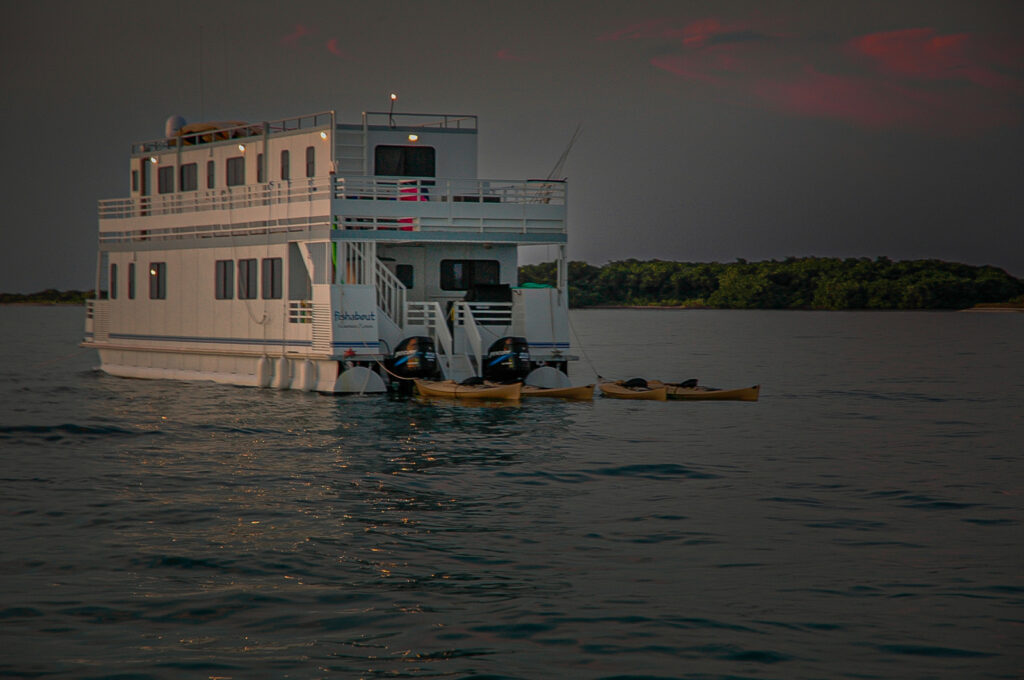 The next morning, after coffee and breakfast, we checked the weather, made a few last-minute phone calls while we still had service, and loaded the fishing gear in the skiffs. Then we headed out to the Marquesas ahead of Fishabout. We ran across the Ship Channel, then through Lakes Passage, past Barracuda, Man, Ballast, and Woman Keys, before crossing Boca Grande Key and finally Boca Grande Channel.
The next morning, after coffee and breakfast, we checked the weather, made a few last-minute phone calls while we still had service, and loaded the fishing gear in the skiffs. Then we headed out to the Marquesas ahead of Fishabout. We ran across the Ship Channel, then through Lakes Passage, past Barracuda, Man, Ballast, and Woman Keys, before crossing Boca Grande Key and finally Boca Grande Channel.
The Ship Channel is deep and relatively narrow, and getting across to the shallower, protected Lakes Passage can be a bit of a test, especially on windy days. But Boca Grande Channel is another thing entirely. It’s wide, far from civilization, deep in places – over 30 feet. And it’s where the waters of the Gulf and the Atlantic come together. That confluence can create some of the gnarliest conditions in the Keys, especially when the wind and current work against each other.
But on this run, the conditions were decent, and we made it out without issue.
West of Key West, bordered by the Florida Keys National Marine Sanctuary, the Marquesas are a broken ring of low islands with beaches and mangroves. They surround a natural harbor, cut through with numerous channels and surrounded by flats. From above, they look like an atoll, but they’re not. Atolls form when coral builds up around sinking volcanic islands, like you’d find in the Pacific. The Marquesas were shaped by tides, currents, and shifting sand, though some researchers believe a meteor impact may have helped form the ring and the deeper harbor.
Just west of the Marquesas lie the Quicksands, a vast, shifting stretch of shallow water and hidden bars. It looks harmless from the surface, but it has swallowed ships, claimed treasure, and earned its name the hard way.
That first morning, we were fishing off the beach on the southwest corner of the island. Push poles and fly rods in hand, partly cloudy skies overhead, and barely a ripple on the water. Like most calm mornings in the Marquesas back in the early 2000s, you expected to see tarpon rolling everywhere, and they were. It was shaping up to be a solid day of fishing with plenty of shots, hookups, and a few fish already to both our skiffs. By midday, we were motoring back toward the anchorage to meet up with the mothership for lunch, followed by siestas and then back out on the water later that afternoon, until nightfall.
The Anchorage
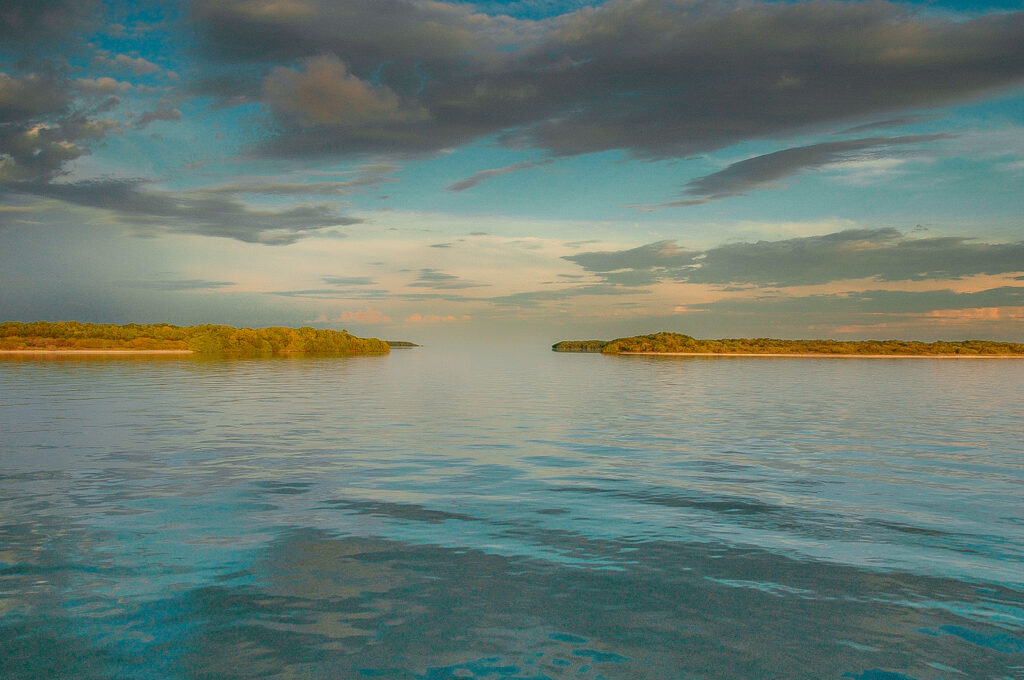 We anchored Fishabout on the southwest side of the Marquesas, our favorite spot. The bottom there held an anchor better than most places around the island. We’d learned that the hard way over time, and the commercial boats that worked these waters for snapper, crab, and lobster seemed to agree. Even Jack Nicklaus used to anchor there when he came chasing tarpon on his super-yacht The Golden Bear, so we figured we were in decent company. But the feeling may not have been mutual, we were the guys in the Winnebago camping next to the Prevost Coach.
We anchored Fishabout on the southwest side of the Marquesas, our favorite spot. The bottom there held an anchor better than most places around the island. We’d learned that the hard way over time, and the commercial boats that worked these waters for snapper, crab, and lobster seemed to agree. Even Jack Nicklaus used to anchor there when he came chasing tarpon on his super-yacht The Golden Bear, so we figured we were in decent company. But the feeling may not have been mutual, we were the guys in the Winnebago camping next to the Prevost Coach.
Our mothership, Fishabout, gave us a huge advantage. We were already in position, casting to tarpon before the guides from Key West had even splashed their skiffs. And we didn’t have to cross Boca Grande Channel every morning, which could go from tame to dangerous in minutes if the weather turned. It was mid-July, already, well into hurricane season, and the forecast showed a system building, but we figured we had time.
The four of us were running the show on this trip: me, Captain Mike Burgreen, Captain John Turcott, who doubled and switched off as crew and guide with Captain Andy Putetti.
That following morning, we had our two skiffs spread out a half-mile off the beach and a mile apart on the northeast side of the island. Fly rods in hand, clear skies overhead, and barely a ripple on the water. We were getting great shots and good luck all morning, with multiple hookups. We fell into our comfort zone, and by midday, we were making our short ride back to the anchorage to meet up with Fishabout for lunch.
Life Aboard Fishabout
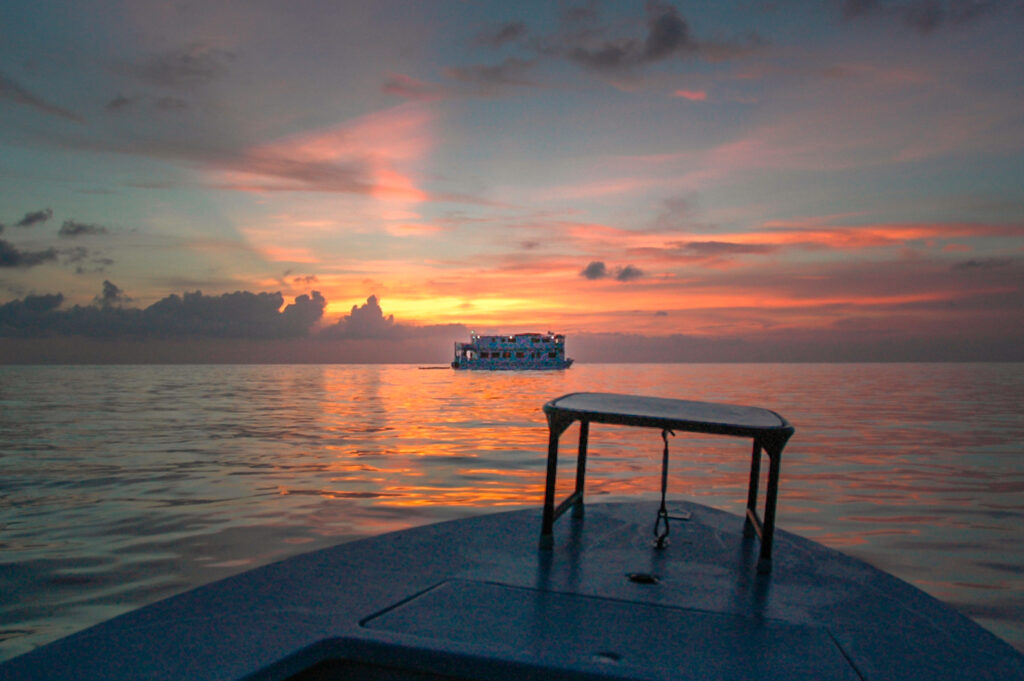 Fishabout was no beauty, but she was seventy feet long, sixteen feet wide, and custom-built. We designed and built her from scratch to be part expedition vessel, and part floating lodge. On the main deck were four staterooms, three full heads with oversized showers for the guests. Each guide had a private cabin up top on the second level, with a shared lounge, head, and shower. The captain’s cabin (Mike’s) and the watch cabin (mine) were adjoined to the wheelhouse and shared an ensuite head and shower.
Fishabout was no beauty, but she was seventy feet long, sixteen feet wide, and custom-built. We designed and built her from scratch to be part expedition vessel, and part floating lodge. On the main deck were four staterooms, three full heads with oversized showers for the guests. Each guide had a private cabin up top on the second level, with a shared lounge, head, and shower. The captain’s cabin (Mike’s) and the watch cabin (mine) were adjoined to the wheelhouse and shared an ensuite head and shower.
We had central air and heat, a 1,200-gallon-a-day water maker, and hot showers at the end of a long day on the water; amenities that seemed impossible once you left the mainland. The main salon had a full bar, ice maker, and satellite TV for those who couldn’t quite quit the world. There was also a TV in every cabin, each with its receiver, fed by a satellite tracking system that kept the signal locked in no matter where we were or how much we were moving. All powered by dual 20KW generators.
Dinner was served at a large table next to the galley. Mike’s meals were amazing. Fresh-caught fish, innovative homegrown recipes, island-style comfort food, and full-blown plated dinners that had no business coming out of a kitchen floating thirty miles from the nearest restaurant. Some of these recipes would be served in his restaurant years later at MA’s Fish Camp, in Islamorada. Fishabouts’ galley was very much his kitchen, and he was the boss. If we’d hung a sign at the door, it would’ve said “Enter at Your Own Risk.”
Mornings always started early. Coffee by 5 AM, breakfast served before 6 AM. The skiffs were prepped the night before by the crew, and we’d usually be poling the edge of the flats by sunrise. Lunch would already be packed in our coolers with ice and drinks, or we’d eat back on the mothership, depending on where the fishing had taken us. And afternoon fishing would resume whenever the anglers wanted to get back at it.
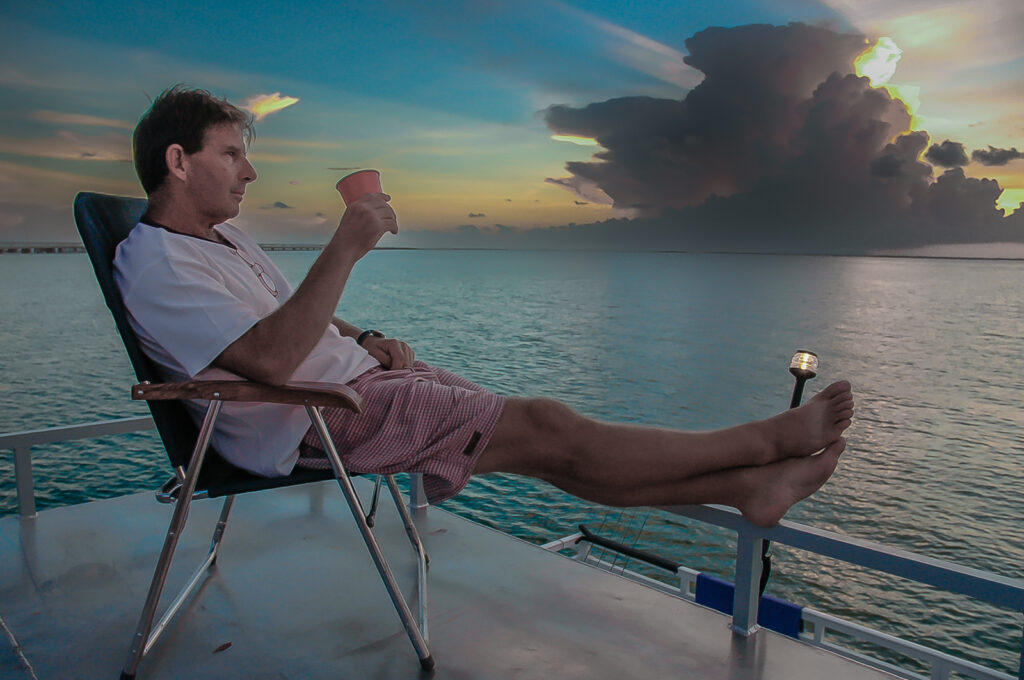 Evenings were the good part, at least most of the time. After fishing, the crew took care of everything; gear and skiffs washed and rinsed, drinks poured, and appetizers on the table while Mike finished dinner. Everyone came back tired and happy. Appetizers might be conch fritters, crab cakes, shrimp cocktails, or whatever Mike had planned. He kept the provision inventory to himself, and with a commercial-grade refrigerator on board, we never knew what he’d pull out next.
Evenings were the good part, at least most of the time. After fishing, the crew took care of everything; gear and skiffs washed and rinsed, drinks poured, and appetizers on the table while Mike finished dinner. Everyone came back tired and happy. Appetizers might be conch fritters, crab cakes, shrimp cocktails, or whatever Mike had planned. He kept the provision inventory to himself, and with a commercial-grade refrigerator on board, we never knew what he’d pull out next.
Dinner was often something you’d expect in a top Keys restaurant: blackened yellowtail, grilled mahi, pasta with conch, or maybe shrimp and grits. Dessert? Usually Key Lime pie, and no one ever skipped it. Sometimes he would cook the crew a separate meal if we didn’t have enough fish or steak. He’d smoke a meatloaf or cook burgers on the grill, and we loved it. Food always tasted better out there.
Afterward, guests either crashed early or wandered up to the top deck with a drink. Just the water, the sky, and the low line of the Marquesas in the distance. There was no traffic, no noise, no cell service, only a sat phone for emergencies. Just water in every direction, and the hum of the generators. A drink or two, talk about the day’s fishing, and what tomorrow might bring. Off in the distance, a few bobbing anchor lights marked the positions of commercial fishing boats laid up for the night, scattered along the horizon. Distant reminders that we weren’t completely alone.
But in the Marquesas, miles from anywhere, the weather always had the last word. And when it turned, it usually did so without much warning, often at the worst possible time, typically around 3 AM. Waking up to the sound of a GPS proximity alarm meant only one thing: the anchor was dragging, and all hell was about to break loose. Other times, it was the radar alarm going off, which usually meant refugees from Cuba had passed within a hundred yards, and the Coast Guard wouldn’t be far behind.
The storms were brutal, almost always resulting in the mothership clocking on the anchor and dragging. That meant detaching the skiffs and sending the guides out in the dark until things settled down.
The Marquesas sit right on the edge of the Quicksands, a watery graveyard where treasure ships like the Atocha were lost. It’s a place with a long history of things going wrong fast.
Incoming
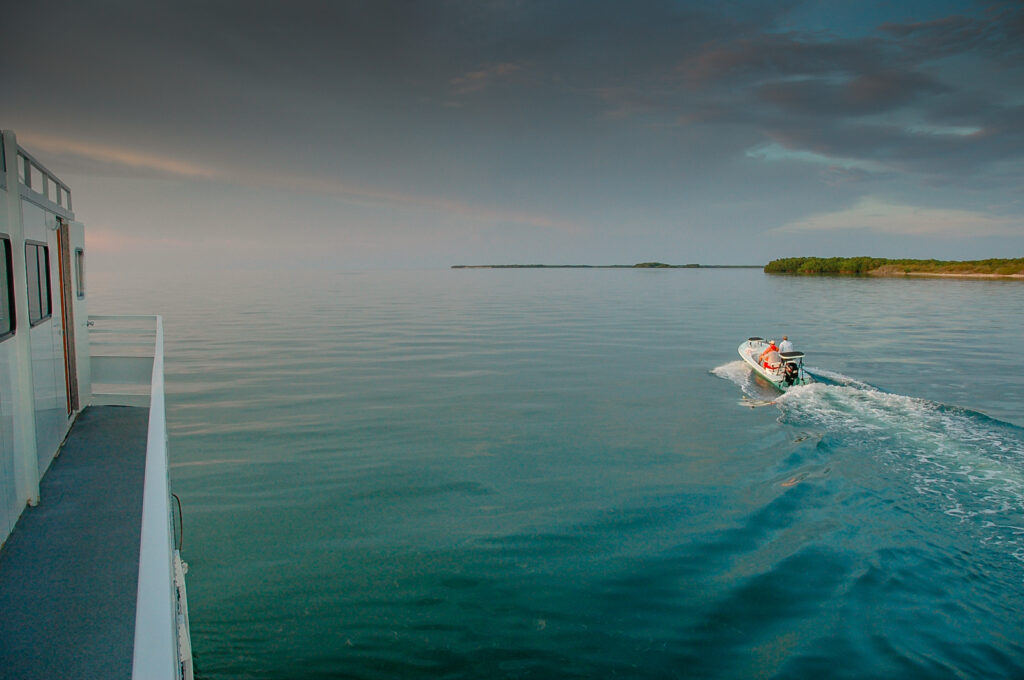 On the third day, it was just after dawn, with our two skiffs, about a mile apart, working one of our favorite early morning tarpon spots again on the northeast side of the island. The light was perfect, the tide just right, and the anglers were dialed in now. Lots of shots, several tarpon landed, and everyone was on their game.
On the third day, it was just after dawn, with our two skiffs, about a mile apart, working one of our favorite early morning tarpon spots again on the northeast side of the island. The light was perfect, the tide just right, and the anglers were dialed in now. Lots of shots, several tarpon landed, and everyone was on their game.
Then we all noticed the same thing.
The sky to the southwest had turned black, low, eerie, and growing. The clouds looked like giant cigars rolling in across the horizon, layered and menacing. There was no thunder yet, no lightning. But the air felt heavier, like something evil just stepped into the room and was getting ready to growl.
We were about five miles from Fishabout, which was anchored around the corner, out of reach and out of sight.
I radioed Andy and, with no hesitation, said, “We’re done fishing for the time being.” Engines fired up, push poles racked, rods laid down. We started idling back toward deeper water, getting ready to hole shot it out of there.
But then we realized we’d be heading straight into it. The storm was growing, moving fast, coming hard out of the southwest, and Fishabout was in that exact direction. Heading straight to the beach was the only option, to not be exposed to whatever the storm might have in store for us.
It was an early rising tide, but the water was too shallow to run straight to the beach. We had to idle in with our engines trimmed out because there wasn’t enough time to pole our skiffs in. And we didn’t want to be the tallest objects on the water. By now, we could hear the thunder and see the lightning flashing to the southwest. And it was happening fast.
Then the rods started hissing. You could hear it; even with the rods stored under the gunwales, an ominous hissing coming off the graphite fly rods and the push pole. Every hair on our arms stood up. The air was charged, and we all knew what that meant. We needed to get off the water, fast.
That’s when we saw John Turcott come flying around the corner of the island in the tender, waving his arms. He was Mike’s crew that day, and from the way he was running, we knew exactly why he was there. He’d been trying to reach us on the radio, but we hadn’t heard him. We didn’t need to. We knew he was coming to warn us and to tell us that Fishabout had already pulled anchor and was making her way around to the east side of the island to meet us whenever we could get there.
Before we even hit the beach, the rain started. Not just rain, but sheets of it that stung on impact. My angler was the owner of a fly shop back in Rochester and had every piece of gear imaginable, but somehow had forgotten the most important piece of gear aside from his fly rods, and polarized shades, His rain jacket. Even in mid-July, this rain was ice cold. I gave him mine.
Hitting the Beach
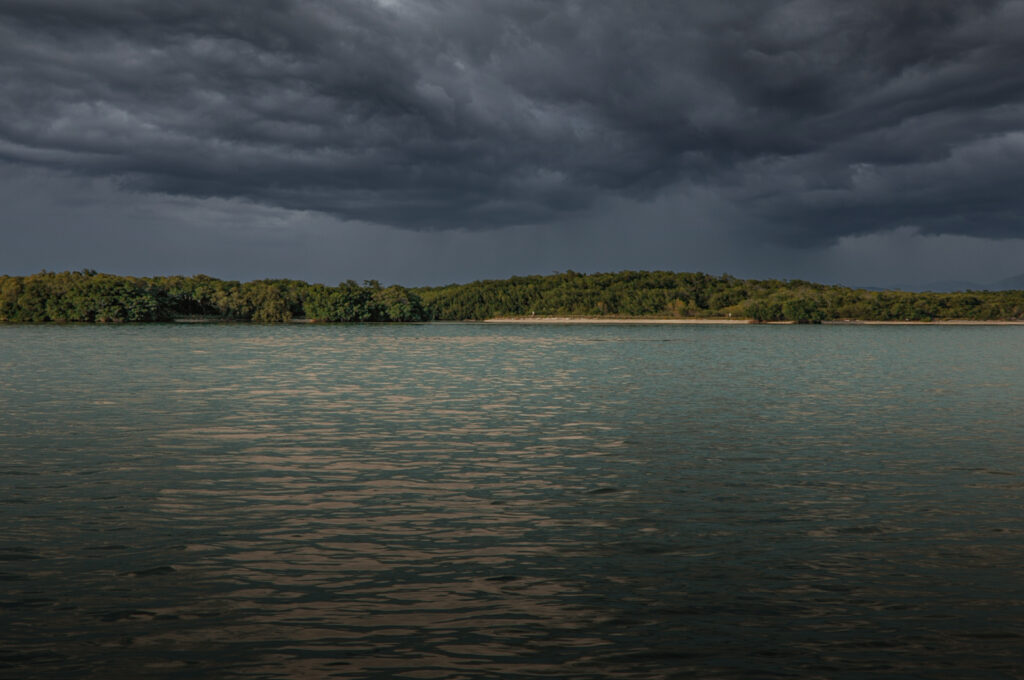 Idling about a half a mile, we reached the beach just in time. The wind came with even heavier rain, slamming into the island in gusts strong enough to bend the stunted mangroves. We beached the skiffs quickly and got everyone off the water. There wasn’t much cover, but we hunkered down behind patches of scrub, trying to stay low and out of the wind and rain.
Idling about a half a mile, we reached the beach just in time. The wind came with even heavier rain, slamming into the island in gusts strong enough to bend the stunted mangroves. We beached the skiffs quickly and got everyone off the water. There wasn’t much cover, but we hunkered down behind patches of scrub, trying to stay low and out of the wind and rain.
No one said a word for a while, not because we were scared, though we were, but because it was loud. Wind howling, rain pounding, thunder cracking above us. Lightning lit up the sky in flashes that turned the shoreline white. We could see strikes hitting within a hundred feet, and the lightning and thunder were instantaneous, and right on top of us. The was no point in counting to estimate how far away it was. Because there was no pause between the thunder and lightning. To this day, I’ve never seen anything like it.
Two of the guys were lying down flat in the sand, trying to stay low. Pulling off anything metal, watches, and fishing pliers, and burying them in the sand. Nobody knew if it helped, but with that much electricity in the air, it felt like the smart thing to do. We weren’t worried about gear; we just didn’t want electricity conducting through us if it came to that.
At that point, I was shaking uncontrollably and questioning my sanity for giving my angler my rain jacket. The rain felt like it was near freezing, and the air temperature was still in the 80s. I couldn’t get warm. Eventually, I climbed back into my skiff and wedged myself under the gunwale, up against the side of the boat that had held onto a little warmth from the earlier air temperature. I grabbed my PFDs and throw cushion and covered myself up the best I could. It helped,
Nobody knew how long the storm lasted, and it never really completely stopped. John had looked at the mothership’s radar before he left to find us and said it was nothing but solid red. But it finally eased up enough to formulate a plan. We would make a run for it and meet Mike at the mothership while we had a lull. NOAA was still issuing marine warnings for severe storms between Key West and the Dry Tortugas, and we were right in the middle. Plus, there was a tropical system in the Florida Straits that had turned into an Invest moving north. Mike made the call to pull the plug on the trip with just one more day remaining.
Making The Call
 Mike’s decision wasn’t up for debate, and nobody questioned it. We had enough provisions to last a week, so that wasn’t an issue. We still had plenty of fuel and a day left in the plan, but pushing on in those conditions would’ve been reckless. The weather wasn’t breaking. It was regrouping for just the second inning.
Mike’s decision wasn’t up for debate, and nobody questioned it. We had enough provisions to last a week, so that wasn’t an issue. We still had plenty of fuel and a day left in the plan, but pushing on in those conditions would’ve been reckless. The weather wasn’t breaking. It was regrouping for just the second inning.
We finally got back to the mothership late that morning, soaked and cold. Mike and John daisy-chained the skiffs off the stern of the vessel. Everything that could be lashed down was. Inside, the mood was tense, gear stowed, engines running, radar glowing red, and NOAA marine warnings blaring over the radio. Nobody had much to say. We weren’t spooked, but we were beat, and we knew we had a long run ahead. And by early afternoon, it was too rough to tow any of the skiffs, including the tender.
Ordinarily, it’s a straight six-mile shot across Boca Grande Channel to the Lakes Passage that starts at Boca Grande Key. But now the wind was gusting to 30 knots out of the south. We knew it was going to be bad. Fishabout wasn’t designed for these kinds of conditions. We decided it was too rough to tow the two skiffs and the tender, so the guides had to run them across, which meant running straight down the ditch for six miles.
Mike and Andy volunteered to run the skiffs and meet up on the lee of Boca Grande Key. While our anglers were doing their best to keep calm downstairs in the main salon, John and I were sweating bullets upstairs in the wheelhouse. The problem was that we couldn’t run straight down the ditch to Boca Grande without the risk of capsizing. So, John, who was at the helm, had to quarter the waves to the southeast, which was taking us farther out to sea, way out. But the skiffs didn’t have a problem, the current was running with the wind, and the waves were spaced out enough to stay between the huge swells. But that’s a different story in a top-heavy seventy-footer with a sixteen-foot beam.
Mike managed to stay with us in the tender – his 18′ Egret skiff. More seaworthy than our 16′ Maverick Mirages, which were smaller with lower freeboard. Occasionally, he would disappear between the swells, but we could see him gesturing at us to turn as we were still quartering out to sea. I understood what John was doing, he was going to make a “tack” back to the northeast as soon as he saw the opportunity. But there wasn’t an opportunity. Finally, I said to him calmly, “What are you waiting for?” and he replied, “I’m counting the sets, dude, I got this.” A response for the ages.
John, the guide and surfer from Titusville, Florida, aka – ‘THE DUDE’ who’d spent time in the Coast Guard on larger vessels, knew exactly what he was doing. With Mike still gesturing frantically, John finally made the turn, but not without some serious noise down in the main salon. A combination of furniture and appliances was flying everywhere. But thankfully, no one was injured.
We eventually made one more tack back to the southeast, which put us directly in line with the channel markers at Boca Grande Key. One by one, we all regrouped in the lee, temporarily out of the wind, rain, and lightning. It was the longest six miles any of us had ever experienced.
Return to Safe Harbor
 The ride back through the Lakes Passage was relatively uneventful. We knew from previous trips that that’s not always the case, but that’s for a different story. We reattached the skiffs to tow, and the ship channel showed us some mercy, making it back to our anchorage in Key West Harbor by nightfall. Everyone was quiet, worn out, but thankful. Gear was sorted out, and the galley came back to life. Mike served something great as usual, maybe yellowtail or hogfish meuniere, maybe pasta carbonara, nobody remembered later. What we did remember was the feeling of getting anchored up safely, knowing we’d made the right call, and an experience to be remembered for a lifetime.
The ride back through the Lakes Passage was relatively uneventful. We knew from previous trips that that’s not always the case, but that’s for a different story. We reattached the skiffs to tow, and the ship channel showed us some mercy, making it back to our anchorage in Key West Harbor by nightfall. Everyone was quiet, worn out, but thankful. Gear was sorted out, and the galley came back to life. Mike served something great as usual, maybe yellowtail or hogfish meuniere, maybe pasta carbonara, nobody remembered later. What we did remember was the feeling of getting anchored up safely, knowing we’d made the right call, and an experience to be remembered for a lifetime.
A tropical storm developed from the Invest the following day and passed just west of the Marquesas. From that point on, there was always a feeling of excitement along with dread amongst the guides and crew when departing on the Marquesas trip. But this wasn’t the first trip or the last where Mother Nature wreaked havoc upon us.
Epilogue
We hadn’t spent much time scouting in the Marquesas before the mothership trips. But back then, there were so many fish, what looked good was good. Areas that we hadn’t scouted yet still produced. It wasn’t about GPS numbers or satellite imagery, it was about reading the water and trusting what we saw.
We weren’t rookies out there. We had already been through our share of severe weather, enough to know the difference between a close call and real trouble. Running an operation thirty miles from the nearest dock was nothing new to us. Logistics, weather, equipment, we had those parts wired. But that storm, that trip, showed us something you only learn through experience, and usually a little too late. Being prepared is not the same thing as being in control.
After that, every Marquesas trip had a little more edge to it. Still beautiful. Still wild. Still worth it. But never been taken lightly. The imagery doesn’t capture anything close to what we witnessed; cell phones and cameras weren’t as water-resistant as they are now. They were stowed in dry bags. And getting good shots to share on Facebook or Instagram hadn’t become a thing yet,
My customers can attest to the fact that I never talk much about how good fishing was yesterday, last week, or last year. Nobody wants to hear that. Fishing is about enjoying the moment and what lies ahead, not what happened in the past. That’s why I didn’t go into great detail about the fishing in this story, or how many, or how big. All I can say is the fishing was as near perfect as it gets.
There were always fish. Tarpon everywhere. We’d be hanging out on a point casting to tarpon and, looking back at the flat behind us, seeing huge schools of bonefish pushing. And permit were always nearby. We were lucky to have seen it the way we did, when we did.
